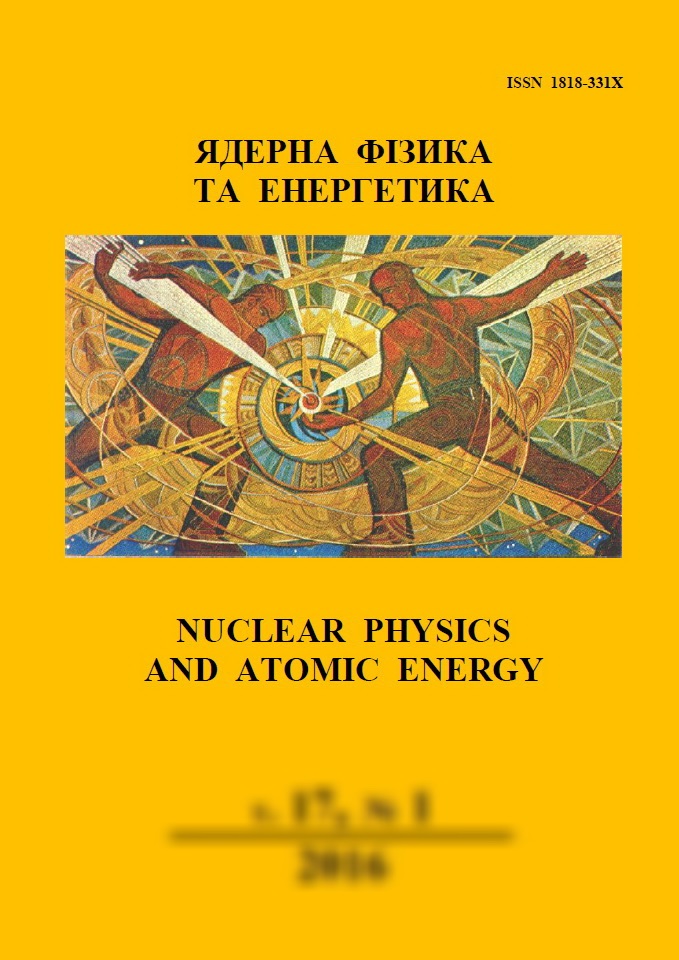 |
ядерна ф≥зика та енергетика
Nuclear Physics and Atomic Energy
ISSN:
1818-331X (Print), 2074-0565 (Online)
Publisher:
Institute for Nuclear Research of the National Academy of Sciences of Ukraine
Languages:
Ukrainian, English
Periodicity:
4 times per year
Open access peer reviewed journal
|
Nucl. Phys. At. Energy 2021, volume 22, issue 2, pages 121-126.
Section: Nuclear Physics.
Received: 05.02.2021; Accepted: 02.04.2021; Published online: 10.09.2021.
 Full text (en)
Full text (en)
https://doi.org/10.15407/jnpae2021.02.121
Spontaneous double alpha decay: First experimental limit and prospects of investigation
V. I. Tretyak*
Institute for Nuclear Research, National Academy of Sciences of Ukraine, Kyiv, Ukraine
*Corresponding author. E-mail address:
tretyak@kinr.kiev.ua
Abstract:
Nuclear decays with simultaneous emission of two alpha particles are energetically possible for a number of nuclides. Prospects of searching for such kind of decay for nuclides present in the natural isotopic composition of elements are discussed here. The first experimental limit on half-life for 2α decay is set for 209Bi as T1/2 > 2.9·1020 y at 90 % C.L., using the data of work [P. de Marcillac et al. Nature 422 (2003) 876]. Theoretical T1/2 estimations for the process are also given. Using these values, which are on the level of 1033 y or more, one can conclude that the prospects of experimental observation of 2α decay are very pessimistic.
Keywords:
double alpha decay, low background experiments, theoretical and experimental half-lives.
References:
1. M. Goeppert-Mayer. Double beta-disintegration. Phys. Rev. 48 (1935) 512.
https://doi.org/10.1103/PhysRev.48.512
2. R. Saakyan. Two-neutrino double-beta decay. Annu. Rev. Nucl. Part. Sci. 63 (2013) 503.
https://doi.org/10.1146/annurev-nucl-102711-094904
3. K. Blaum et al. Neutrinoless double-electron capture. Rev. Mod. Phys. 92 (2020) 045007.
https://doi.org/10.1103/RevModPhys.92.045007
4. W.H. Furry. On transition probabilities in double beta-disintegration. Phys. Rev. 56 (1939) 1184.
https://doi.org/10.1103/PhysRev.56.1184
5. M.J. Dolinski, A.W.P. Poon, W. Rodejohann. Neutrinoless double beta decay: Status and prospects. Annu. Rev. Nucl. Part. Sci. 69 (2019) 219.
https://doi.org/10.1146/annurev-nucl-101918-023407
6. M. Goeppert. Uber die Wahrscheinlichkeit des Zusammenwirkens zweier Lichtquanten in einem Elementarakt. Naturwissenschaften 17 (1929) 932.
https://doi.org/10.1007/BF01506585
7. M. Goeppert-Mayer. Uber Elementarakte mit zwei Quantensprungen. Ann. Phys. (Leipz.) 401 (1931) 273.
https://doi.org/10.1002/andp.19314010303
8. G. Sutter. Étude experimentale de la double émission gamma dans les transitions monopolaires des noyaux 16O, 40Ca et 90Zr. Ann. Phys. (Paris) 13 (1963) 323.
https://doi.org/10.1051/anphys/196313080323
9. C. Walz et al. Observation of the competitive double-gamma nuclear decay. Nature 526 (2015) 406.
https://doi.org/10.1038/nature15543
10. M. Pfutzner et al. Radioactive decays at limits of nuclear stability. Rev. Mod. Phys. 84 (2012) 567.
https://doi.org/10.1103/RevModPhys.84.567
11. Yu.N. Novikov. Some features of nuclei close to the boundaries of nucleon stability. Int. Workshop on U 400 Program. JINR (1979) p. 15.
12. E.E. Berlovich, Yu.N. Novikov. One- and many-nucleon radioactivity of atomic nuclei. In: B.S. Dzhelepov (ed.). Modern Methods of Nuclear Spectroscopy 1986 (Leningrad, Nauka, 1988) p. 107.
13. D.N. Poenaru, M. Ivascu. Two alpha, three alpha and multiple heavy-ion radioactivities. J. Physique Lett. 46 (1985) 591.
https://doi.org/10.1051/jphyslet:019850046013059100
14. D.N. Poenaru, M.S. Ivascu. Particle Emission from Nuclei, Vol. II: Alpha, Proton, and Heavy Ion Radioactivities (USA, CRC Press (1989) 271 p.
Google books
15. W. von Oertzen. Alpha-cluster condensations in nuclei and experimental approaches for their studies. In: C. Beck (ed.). Clusters in Nuclei. Vol. 1 (Germany, Springer, 2010) 328 p. (Lecture Notes in Physics 818).
https://doi.org/10.1007/978-3-642-13899-7_3
16. M. Wang et al. The Ame2016 atomic mass evaluation. (II). Tables, graphs and references. Chin. Phys. C 41 (2017) 030003.
https://doi.org/10.1088/1674-1137/41/3/030003
17. P. Belli et al. Experimental searches for rare alpha and beta decays. Eur. Phys. J. A 55 (2019) 140.
https://doi.org/10.1140/epja/i2019-12823-2
18. R. Bernabei et al. First model independent results from DAMA/LIBRA-phase2. Yaderna Fizyka ta Energetyka (Nucl. Phys. At. Energy) 19 (2018) 307.
https://doi.org/10.15407/jnpae2018.04.307
19. E. Aprile et al. The XENON1T dark matter experiment. Eur. Phys. J. C 77 (2017) 881.
https://doi.org/10.1140/epjc/s10052-017-5326-3
20. G. Alimonti et al. The Borexino detector at the Laboratori Nazionali del Gran Sasso. Nucl. Instrum. Meth. A 600 (2009) 568.
https://doi.org/10.1016/j.nima.2008.11.076
21. J. Meija et al. Isotopic compositions of the elements 2013 (IUPAC Technical Report). Pure Appl. Chem. 88 (2016) 293.
https://doi.org/10.1515/pac-2015-0503
22. R.B. Firestone et al. Table of Isotopes. 8th ed. (USA, John Wiley & Sons, 1996) and CD update (1998).
https://www.wiley.com/en-us/Table+of+Isotopes%3A+1999+Update%2C+8th+Edition-p-9780471356332
23. D.N. Poenaru et al. Systematics of cluster decay modes. Phys. Rev. C 65 (2002) 054308.
https://doi.org/10.1103/PhysRevC.65.054308
24. V.I. Tretyak. Semi-empirical calculation of quenching factors for ions in scintillators. Astropart. Phys. 33 (2010) 40.
https://doi.org/10.1016/j.astropartphys.2009.11.002
25. S. Pirro, P. Mauskopf. Advances in bolometer technology for fundamental physics. Annu. Rev. Nucl. Part. Sci. 67 (2017) 161.
https://doi.org/10.1146/annurev-nucl-101916-123130
26. P. de Marcillac et al. Experimental detection of α-particles from the radioactive decay of natural bismuth. Nature 422 (2003) 876.
https://doi.org/10.1038/nature01541
27. G.J. Feldman, R.D. Cousins. Unified approach to the classical statistical analysis of small signals. Phys. Rev. D 57 (1998) 3873.
https://doi.org/10.1103/PhysRevD.57.3873
28. G.W. Kim et al. Improved intensities for the γ transitions with Eγ > 3 MeV from 208Pb*. Phys. Rev. C 102 (2020) 064306.
https://doi.org/10.1103/PhysRevC.102.064306
29. V.I. Tretyak. Spontaneous double alpha decay: First experimental limit and prospects of investigation. arXiv:2102.12005v1 [nucl-ex] 24 Feb 2021.
https://arxiv.org/abs/2102.12005
30. F. Mercier et al. Microscopic description of 2α decay in 212Po and 224Ra isotopes. Phys. Rev. Lett. 127 (2021) 012501.
https://doi.org/10.1103/PhysRevLett.127.012501
